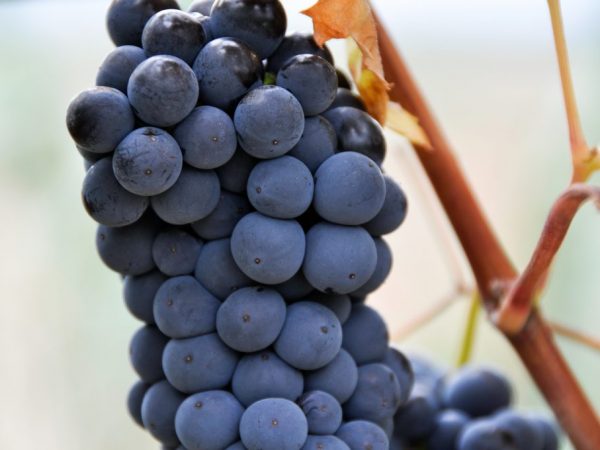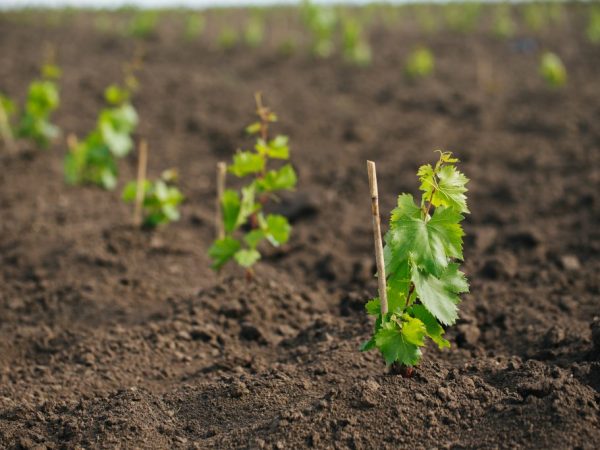Vograd Regent: variety description
The Regent grape is described as a new hybrid variety that was developed by crossing Diana and Chamboursen grapes.

Grape Regent
Characteristics of grapes
The Regent grape is a technical variety, the berries ripen in the middle of autumn, intended for the production of red wines with a thick coloration. The ripening period of the Regent grape bunches is 135-140 days.
Advantages of Regent grapes:
- high level of productivity;
- delicious berries and their attractiveness;
- disease and pest resistance;
- sufficient ripening rate and rooting rate of seedlings;
- frost resistance - grapes can withstand temperatures up to -27 ° C, does not require additional shelter in winter;
- versatility - fruits are suitable for fresh consumption, making wines, juices;
- usefulness - it contains a large number of vitamins, antioxidants, active pigments, is a source of energy and vitality.
Disadvantages:
- the variety requires timely harvesting, otherwise the berries will begin to crumble;
- a medium-late variety will not have time to ripen in the northern regions;
- the composition of the soil is important for the growth of grapes, it is required to monitor the presence of nutrients in it.
Description of the bush
According to the description, the bush of the Regent variety is deciduous, small in size, reaches 4 m in height, is able to branch strongly. The leaves are bright green with light veins, large in size, have jagged edges.
Description of fruits
- round, medium-sized berries, deep dark blue, almost black;
- the pulp is juicy;
- the weight of one berry is 1-2 g;
- sugar content 20-22%, acidity 8 g / l;
- harmonious nutmeg aroma with herbaceous notes.
According to the description of the Regent grape variety, the brush is cone-shaped, its weight is 170-180 g, the number of fruits is moderate.
Growing grapes
Landing in the soil
Planting is carried out in the spring, when the ground has already warmed up and there is no threat of frost. It is possible to plant seedlings in the fall before the onset of frost, while the bush will have time to adapt to new conditions and take root.

Choose sunny places for grapes
Grapes grow best in bright, open areas without wind, on the south or southwest side of the garden.
Planting stages:
- prepare a pit with dimensions of 80 * 80 * 80 cm;
- put a peg in the center of the hole, this will serve as a support for the plant;
- a drainage of medium grain gravel or broken brick is laid down the hole;
- organic and mineral fertilizers mixed with the soil are added on top;
- the pit is filled up to a third with earth and watered with water;
- in the central part, a hill is formed, where the roots of the seedling are distributed, the stem is tied to a support;
- the plant adheres and is covered with soil;
- the seedling is watered, mulched around the plant with peat;
- seedlings are planted at a distance of 1.5 m from each other.
Plant care
The regent requires compliance with the conditions for care, when they are fulfilled, it will be able to give a good harvest: optimal soil moisture, timely watering, weeding - removing weeds, loosening the earth.
Fertilizer
The composition of the soil for the Regent variety is important; for this, top dressing is carried out with the necessary nutrients for the grapes. Before planting seedlings, the soil is fertilized with compounds with magnesium. Growth is stimulated by the introduction of organic and mineral fertilizers, feeding is carried out by root and foliar methods. Substances are added in the amounts indicated in the instructions, otherwise their excess will harm the plants.
Watering
The Regent grape variety needs regular watering. The Regent should be watered in the spring before and after flowering and in the summer when the berries are preparing to ripen.
Pruning
Pruning vines plays an important role in plant development. Damaged shoots are necessarily removed, partly - stepchildren, this allows nutrients to get to the berries and distribute the load on the bushes. Also, annual vines are shortened by 3 cm from the lower eye, lignified lateral branches are pruned by 2/3 of the length, the tops are pinched 10 days before flowering for better development of the bushes.
Diseases and pests
It is possible not to use pesticides when growing, but fertilizers are required to maintain plant immunity.
With improper care, the bushes are susceptible to mildew fungus, with it leaves and shoots are affected. Downy mealy rot is manifested by yellow spots, they gradually darken and become moldy. Mildew can spread to inflorescences and clusters, subsequently this will lead to loss of yield. During the ripening period, the disease provokes shrinking and falling off of berries.
Oidium - powdery mildew, observed at any stage of growth on leaves, shoots in the form of mold. The reproduction of oidium is active, therefore, at the end of the growing season, the foliage is covered with a dense felt layer. With this pest, the berries burst. Outbreaks of the disease occur in the spring and summer.
Disease and pest control
In order to avoid the development of diseases and pests, Regent grape bushes are treated with sulfur, Skor and Topaz preparations. They should be used according to the instructions.
Conclusion
The Regent grape is an excellent variety for the production of vintage wines, juices and fresh consumption. Observing all the requirements of the plant for cultivation and care, an excellent harvest of berries is obtained.

